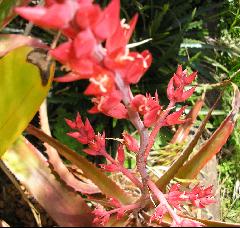
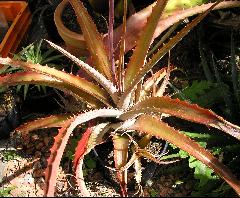
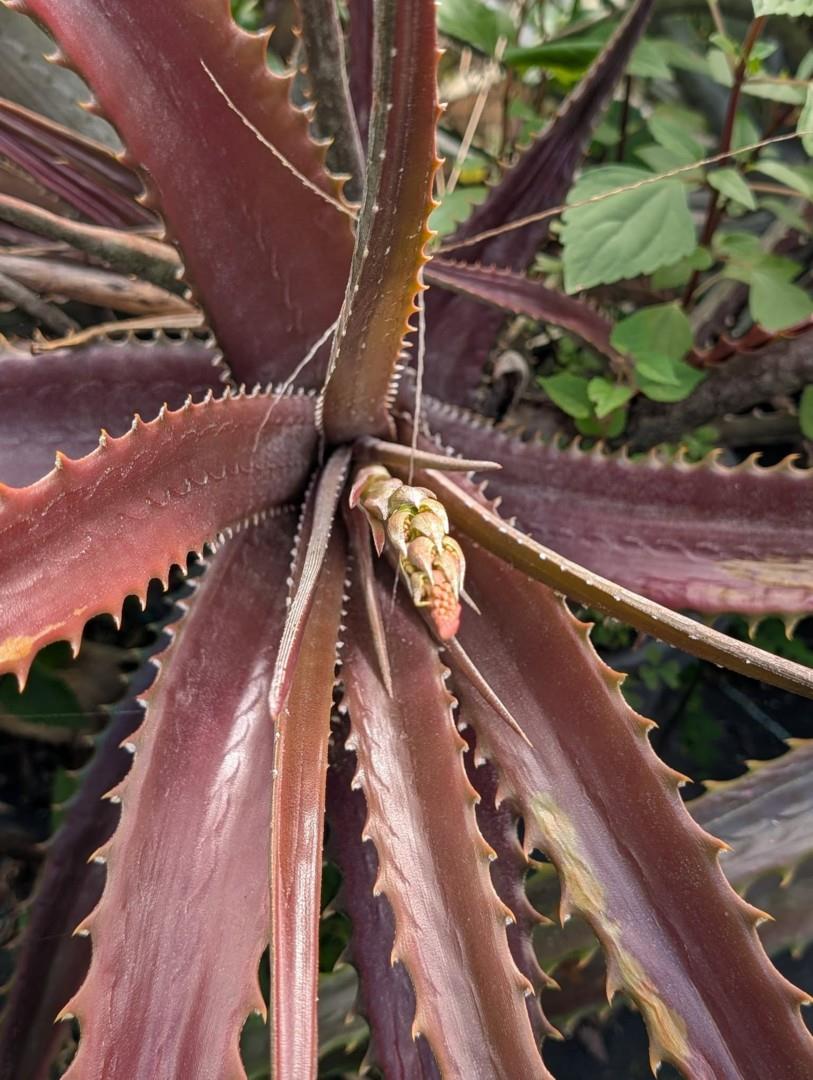
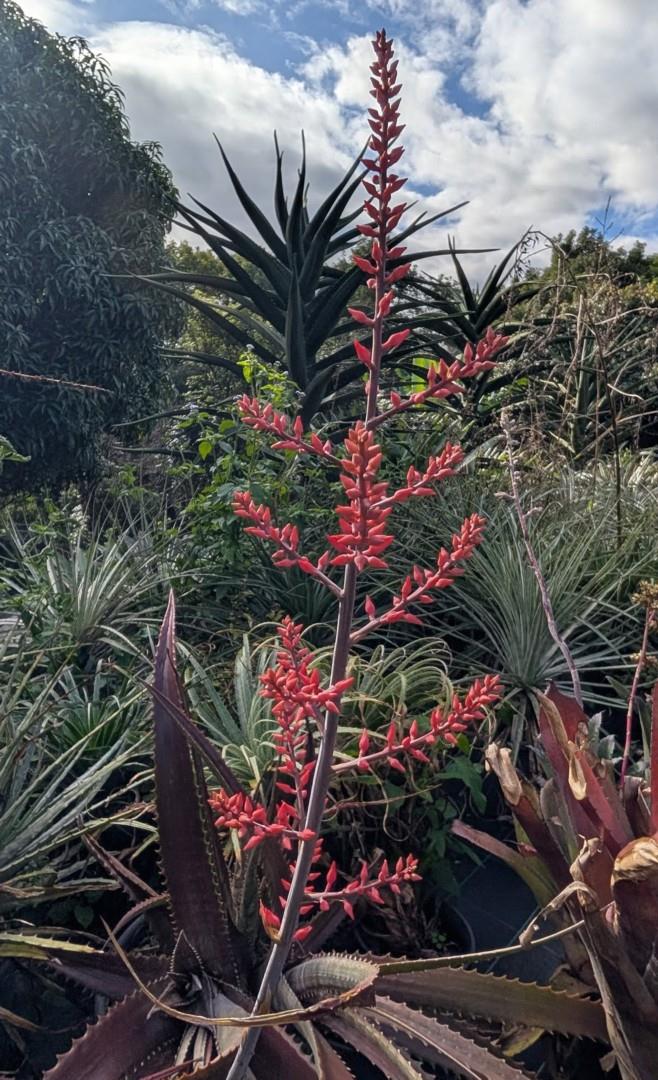
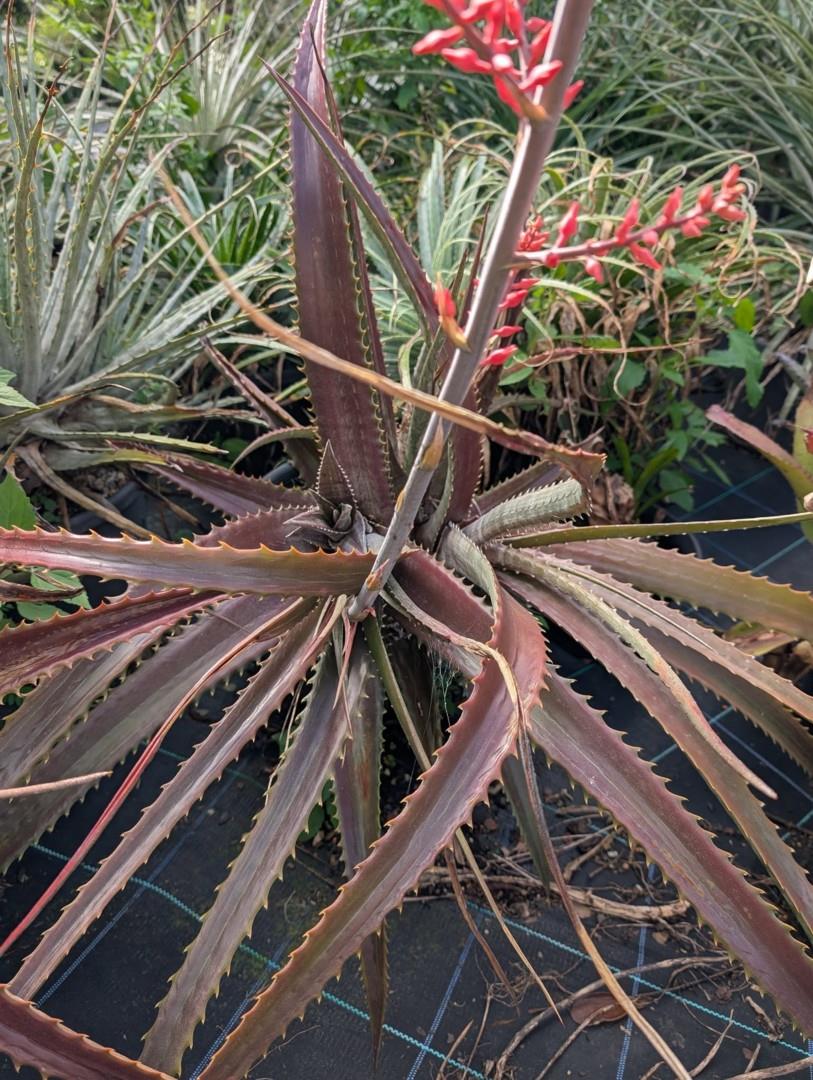
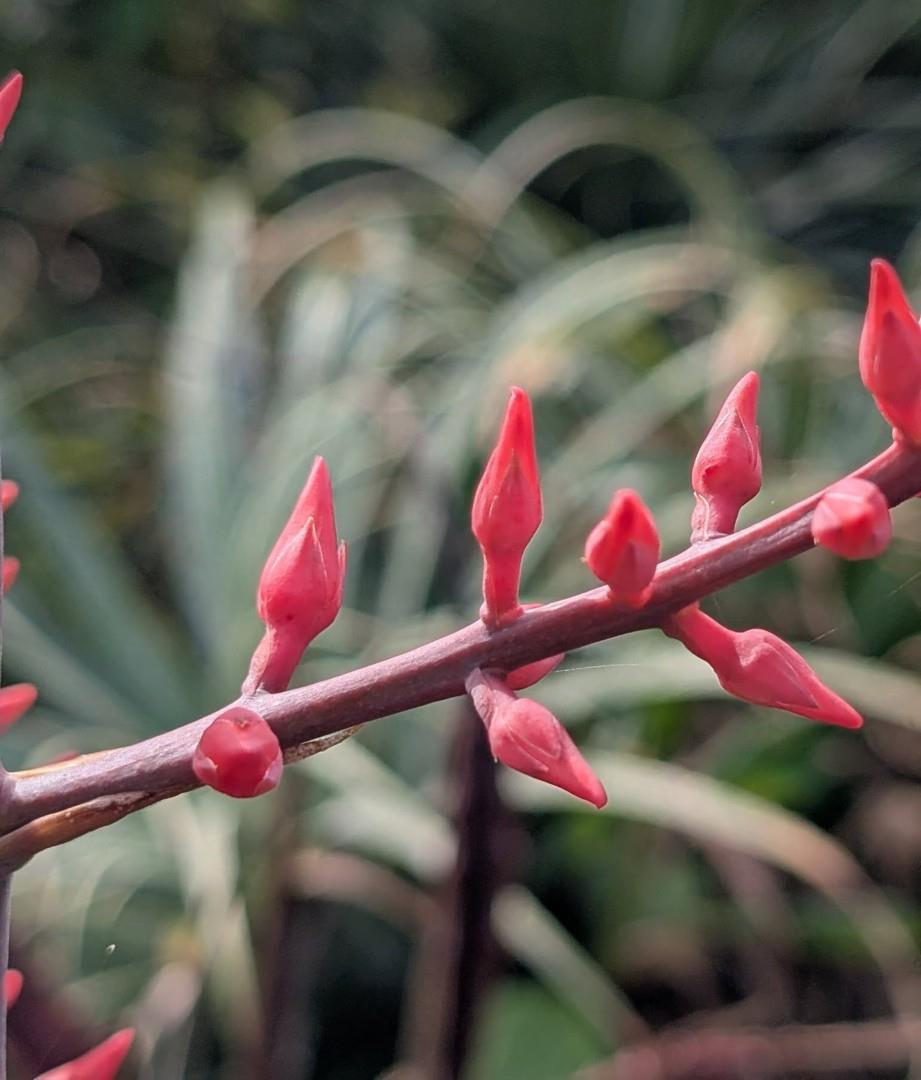
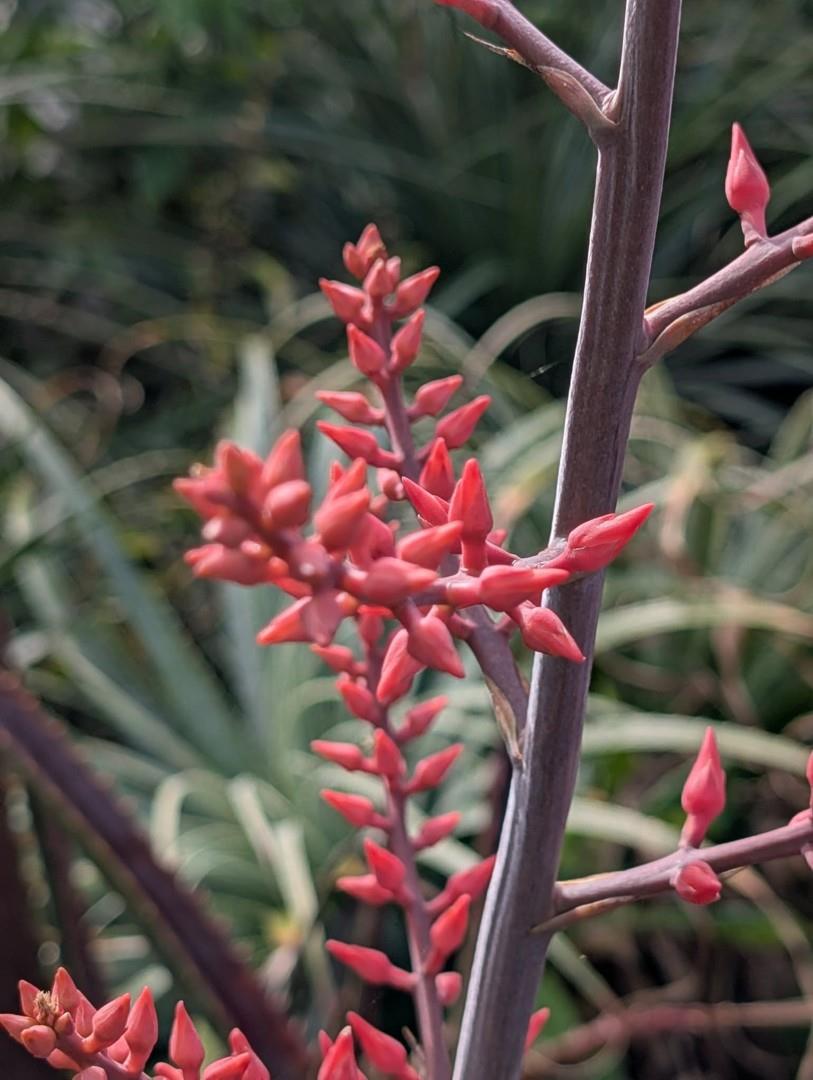
No reasons were given for this move nor any description published.
22/08/2012, Ivon Ramirez wrote:
Dear Derek:
Hechtia rosea is very different from H. meziana based only on vegetative characters (rosea has maroon or reddish leaves, meziana yellow-greenish leaves), but flowers (both sexes) look very similar, just a minute difference on pistillate flowers (ovary size) but nothing else, although they occur in different biogeographical areas. Hechtia desmetiana seems very different based on type and illustration (larger and pedicellate flowers and larger fruits), we have not found any population matching these type thus probably it was a monster or the artist was very creative! Also, it does not help that there is no type locality! And finally Hechtia macdougallii is probably a synonym of H. rosea, I do not see any difference. Please, consider the name of H. iltisii as well, another red-flowered Hechtia from Jalisco, this I have not collected it yet!
I am preparing classes, bye!
Ivon
Protologue
Hechtia desmetiana (Baker) Mez, DC. Monogr. Phan. 9: 551. 1896.
Hechtia macdougallii L. B. Smith, Phytologia 18: 138, pl. 1, figs. 4-6. 1969.
Hechtia meziana L. B. Smith, Proc. Am. Acad. (Contr. Gray Herb. 106:) 70: 149, pl. 1, figs. 2, 3. 1935.
Hechtia roezlii hortus ex Baker, Handb. Bromel. 140. 1889; nomen in synon.
Desc from S&D
Plant flowering 12 dm high.
Leaves 5 dm long, densely lepidote on both sides;
sheaths suborbicular, dark-brown;
blades narrowly triangular, over 3 cm wide, armed with coarse uncinate teeth up to 7 mm long and 6-12 mm apart.
Scape elongate, 1 cm in diameter, subglabrous, red;
scape-bracts erect, broadly ovate, the lower ones with a long linear lamina exceeding the internodes, the upper ones merely acuminate, remote.
Inflorescence very laxly bipinnate, broadly pyramidal, 7 dm long, many-flowered, subglabrous, red;
primary bracts like the upper scape-bracts, 4 cm long, usually shorter than the sterile base of the axillary branch;
branches spreading, up to 3 dm long, laxly flowered, somewhat interrupted; rhachis slender, nearly straight.
Floral bracts broadly ovate, abruptly acuminate, 4 mm long, much exceeded by the sepals;
staminate flowers suberect to spreading, subsessile, about 1 cm long.
Sepals broadly ovate, apiculate, 5 mm long, glabrous;
petals elliptic, obtuse, very short-connate, convex, rose;
stamens barely exserted; remnant of the ovary one-third inferior, glabrous.
Capsules ellipsoid, beaked, 22 mm long;
seeds linear with long flat apical appendages.
TYPE. Liege Hortus s n (holotype, LG; photo, GH), "Mexico," flowered 16 Nov 1885.
DISTRIBUTION. Southern Mexico.
MEXICO. VERA CRUZ (?): Laguna Verde, Apr 1841, Liebmann 31 in part (C, photo, US). OAXACA: Bartolome, Dec 1842, Liebmann 31 in part (C, photo, US). WITHOUT LOCALITY: s d (fruit), Liebmann s n (C, photo, US); flowered in cultivation, Oct 1958,MacDougall in Montreal Hortus 1884-46 (US).
5.Hechtia rosea E. Morren ex Baker, Handb. Bromel. 140. 1889.
H. ROSEA E. Morren inedit. (M.D.).
Leaves ensiform-acuminate, l.5-2 ft. long, an inch broad above the ovate base, tapering gradually to a long point, stiffly erecto-patent, much tinged with brown, armed with large ascending hooked pungent marginal prickles. Peduncle erect, longer than the leaves; bract-leaves adpressed, with long red linear tips. Inflorescence a lax panicle 3-4 ft. long, with several long distant ascending or spreading spicate branches, subtended by small scariose lanceolate branch-bracts; flower-bracts minute, ovate. Sepals oblong, 1/4 in. long. Petals bright red, twice as long as the sepals.
Hab. Mexico. Described from Professor Morren's drawing, made Nov., 1885. This may be H. Roezli Hort., said to be "entirely red in summer."
Dyckia desmetiana Baker, Bot. Mag. 120: pl. 7340. 1894.
Bromelia desmetiana hortus ex Baker, Bot. Mag. 1201 pl. 7340. 1894; nomen in synon.
Desc from S&D
Leaves to 4 dm long, sparsely lepidote above, densely and coarsely lepidote below, armed with stout spines 7 mm long.
Scape stout, glabrous;
scape-bracts foliaceous, much exceeding the internodes.
Inflorescence laxly bipinnate, pyramidal, 65 cm long, glabrous;
primary bracts narrowly triangular, about equaling the long sterile bases of the branches;
branches up to 15 cm long, laxly many-flowered.
Floral bracts ovate-elliptic, apiculate, about equaling the pedicels;
flowers 15 mm long, suberect to spreading, only the pistillate phase known; pedicels 7 mm long.
Sepals triangular-ovate, acute, 5 mm long, roseate;
petals narrowly elliptic with a carinate acuminate apex, rose, slightly coherent at base;
ovary glabrous;
style very short.
TYPE. Peacock in Kew Hortus s n (K, photo, GH), 4 May 1893. Described from cultivation; origin unknown, but given as "Brazil" because the species was placed under Dyckia.
DISTRIBUTION. Unknown, but doubtless Mexico, where the closely related H. meziana occurs.
Desc from S&D
Plant flowering about 1 m high, red except the leaves.
Leaves to 7 dm long, very narrowly triangular, 8 cm wide, appressed-lepidote throughout, coarsely repand-serrate.
Scape elongate;
scape-bracts vaginiform, the upper ones about equaling the internodes.
Inflorescence laxly bipinnate, ca 7 dm long, 3 dm in diameter, glabrous;
primary bracts lanceolate or ovate, acuminate, much exceeding the short sterile bases of the branches, thin;
branches spreading, slender, sublaxly flowered.
Floral bracts broadly ovate, apiculate, much exceeding the 2 mm long pedicel;
only the staminate flowers known, spreading.
Sepals broadly subelliptic, acute, 4 mm long;
petals spatulate, subunguiculate, 7 mm long;
stamens barely exceeding the petals; anthers elliptic, 2.5 mm long;
remnant of the ovary largely inferior, making the pedicel appear nearly 4 mm long.
TYPE. MacDougall s n (holotype, US), part shade, in soil on steep bank, Zapotitlan, Oaxaca, Mexico, Dec 1949.
DISTRIBUTION. Oaxaca, Mexico.
MEXICO. OAXACA: Nizanda, 24 Feb 1951, MacDougall 2 (US).
Desc from S&D
Plant flowering about 1 m high, red except the leaves.
Leaves to 9 dm long, very narrowly triangular, 3 cm wide, completely covered with appressed ferruginous or cinereous scales, coarsely and laxly serrate with teeth 6 mm long, but the long-attenuate apex unarmed.
Scape elongate, slender, about 7 mm in diameter, glabrous;
scape-bracts small extremely remote, ovate, acuminate, chartaceous.
Inflorescence very laxly bipinnate, 4-5 dm long and 15-30 cm in diameter, glabrous;
primary bracts like the scapebracts, about half as long as the sterile bases of the branches;
branches slender, laxly flowered.
Floral bracts ovate, acute, equaling or exceeding the pedicels, membranaceous;
pedicels to 3 mm long.
Sepals chartaceous, the staminate narrowly ovate, obtuse, erose, 5 mm long, the pistillate broadly triangular-ovate, acute, 4 mm long;
staminate petals elliptic, obtuse, 7.5 mm long, the pistillate lance-ovate, acute, 8-10 mm long;
stamens included; anthers ovate, apiculate;
ovary glabrous; style very short.
Capsule to 2 cm long; carpels 5 mm in diameter, even, dark brown, soon separating;
seeds narrow, 5 mm long exclusive of the long caudate appendage.
TYPE. Purpus 10276 (holotype., pistillate, NY; isotype, US staminate and fruit), rocky banks, ravines near Monserrate, Chiapas, Mexico, 1925.
DISTRIBUTION. Known from the type collection only.